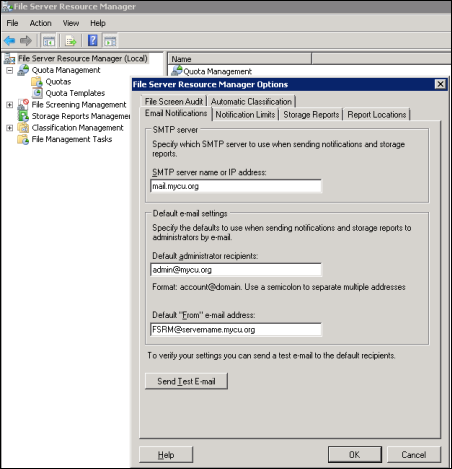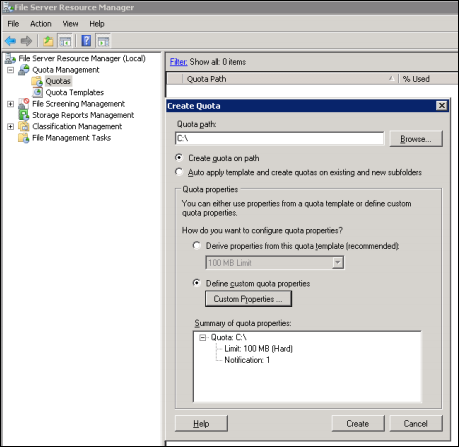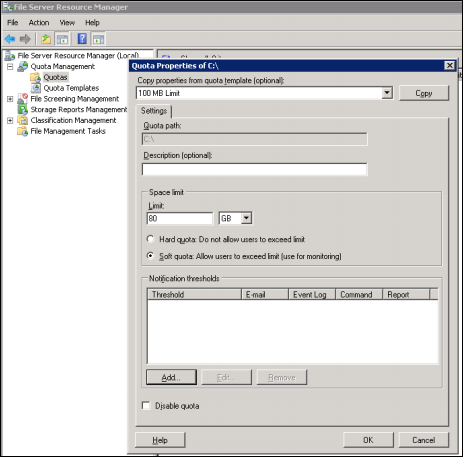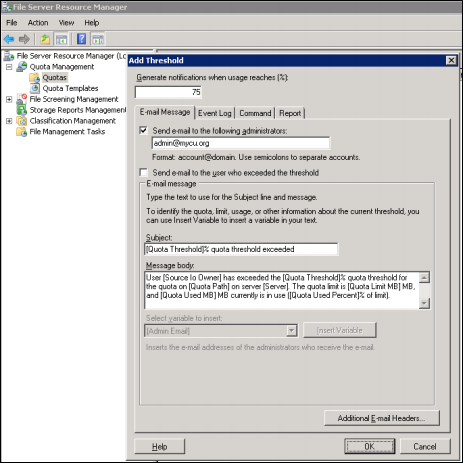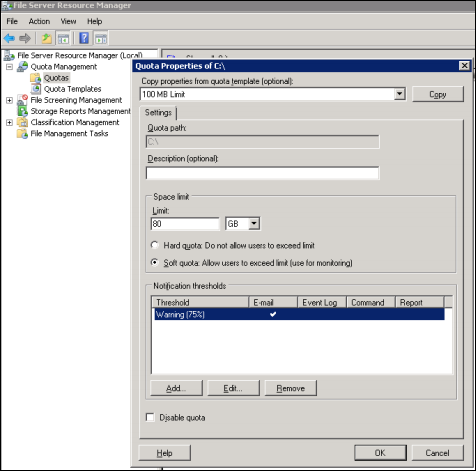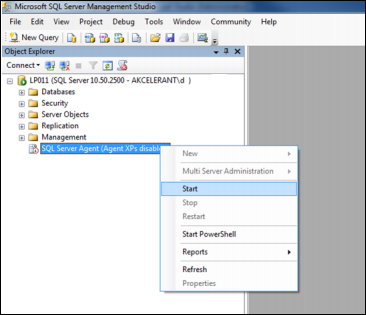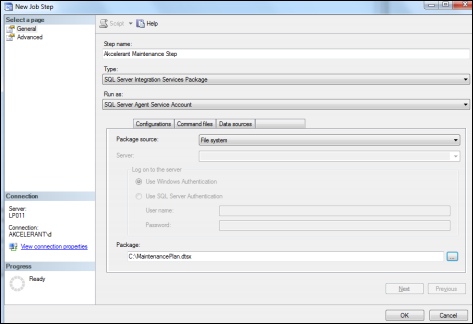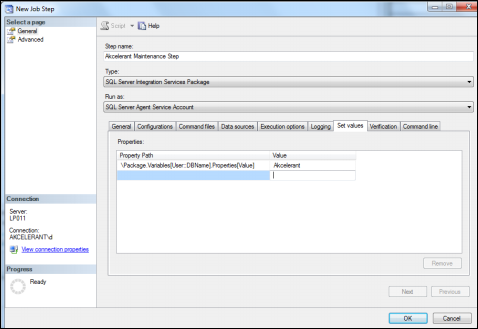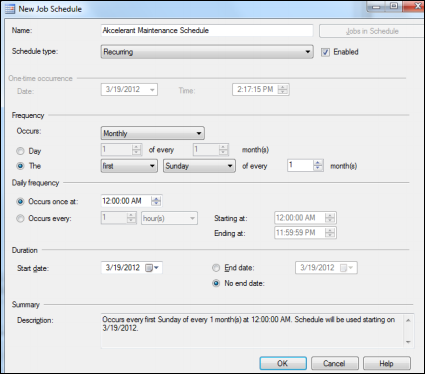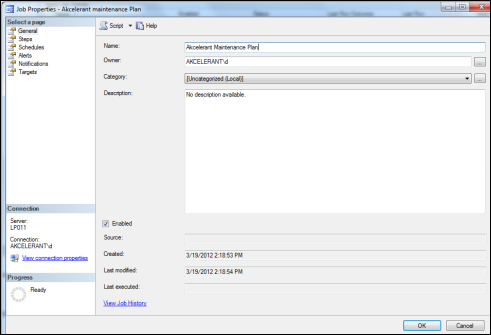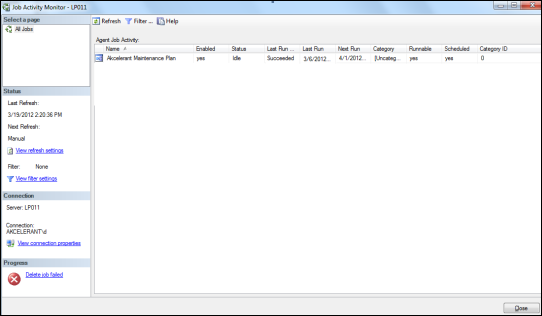This page provides the best practices for maintenance of servers that run the Akcelerant Framework and includes high-level maintenance to very specific strategies for disaster recovery.
 |
This page is only a recommendation to use as a guide. It is the sole responsibility of the customer to design and implement procedures to fit its need, and Akcelerant Software is not liable for any data loss due to malfunctioning backups and maintenance procedures. |
File System Quotas
Through normal usage, the Framework will consume additional disk space over time. On the web/app server, space is consumed by items such as letters, credit reports, archived import files, etc. This consumption is much more prevalent on the database server. The database will continue to grow as new accounts are imported and worked (creating workflows, comments, promise to pays, etc.). Over time, it is possible that a server will run out of disk space. When this happens, the Framework can no longer function and will be down until the space issue is resolved. Most often this problem occurs on the database server and results in the following error:

Through the use of file system quotas, which is a feature built into Windows, a system administrator can be notified via email when the disk usage exceeds a predefined threshold. This proactive monitoring will enable the administrator to take action to resolve the space issue before it affects the Framework and end users.
- Create a file system quota by opening the File Service Resource Manager. If this program is not available, it can be installed through Windows Features in Programs and Features. Under Server Role select File Services and under Role Services select File Server Resource Manager.
- Open the File Server Resource Manager
- To receive email notifications, you must ensure File Server Resource Manager has the proper SMTP settings. Rick-click on the File Server Resource Manager and select Configure Options.
- Enter the information on the Email Notifications tab according to your environment.
- Click the OK button.
- Right-click on Quota Management > Quotas and select Create Quota.
- Enter the drive to monitor for this quota in the Quota Path field.
If the server uses multiple logical/physical drives, you must set up separate quotas for each.
- Select the Define customer quota properties option.
- Click Custom Properties.
- Under Space limit, enter the total drive capacity. The image above shows 80 GB because that is the maximum capacity of the C:/ drive.
- Select Soft Quota option.
- Under Notification thresholds, click Add.
- Enter 75 for the usage percentage
- Check the email administrator option and enter your email address.
- Click OK.
- Add two more notification thresholds for the usage percentages of 85% and 95%.
- Click OK.
- Click Create.
The set up is complete. You will now receive email notifications when the drive(s) reaches 75%, 85%, and 95% of capacity.
Schedule and execute weekly maintenance of your Web, Application and Database servers. This general maintenance will ensure your servers are running efficiently. The maintenance should include the following:
- Run Windows Update and install all “High” and “Critical” patches and hotfixes to ensure all Windows related components and services are up to date and all known vulnerabilities and issues are resolved. If updates are installed, reboot the server.
- Complete maintenance by rebooting the server. This ensures the application runs at peak performance.
Consistent periodic maintenance of the Framework database is important in keeping the Framework running at peak performance. This maintenance should be conducted once per week during off hours. This section will walk you through the steps required in setting up an effective maintenance plan.
Create the maintenance plan by using the SQL Server Agent.
- Download the Akcelerant provided SSIS File found here.
- Save the file where it is accessible from the SQL Server machine.
- Start SQL Server Agent if it is not currently running.
- Right click on SQL Server Agent (Agent XPs disabled) and click Start.
- Right-click on Jobs and click New Job.
- On the New Job dialog, fill out the Name of the new job to Akcelerant Maintenance Plan.
- Click Steps in the left navigation pane and click New at the bottom of the form.
- New Job Step dialog box displays. Complete the following fields:
- Step Name: Akcelerant Maintenance Step
- Type: SQL Server Integration Services Package
- Package source: File System
- Package: Browse to the .dtsx file that was saved on the SQL Server machine.
- Click Set Values tab. Complete the following:
- Property Path: \Package.Variables[User::DBName].Properties[Value]
- Value: Enter in the name of your Akcelerant Framework Database
The Value must match to the Database you are running Akcelerant Framework on.
- Click OK.
- Click on Schedules on the left menu pane and click New.
- A New Job Schedule dialog displays. Enter in the following information:
- Name: Akcelerant Maintenance Schedule
- Schedule Type: Recurring
- Select Enabled check box
- Complete Frequency
Akcelerant recommends running this maintenance once per week on Sunday at 12:00 AM. The customer should consider their daily imports when creating the schedule. Import times can vary for each customer depending on their size, environment, etc. Customers should make sure that the maintenance and imports are not scheduled so that they are running at the same time.
- Click OK.
- Click OK on the Job Properties screen.
- To verify that the job ran successfully, double-click Job Activity Monitor. The dialog box displays the job that was created. Verify the Last Run (Succeeded, Failed, Unknown) and Last Run Date.
High availability is achieved through hardware redundancy. Consider a scenario where the Framework is installed on a single web server. If that server goes down, the Framework is unavailable until the server is back online. If that single server experiences a hardware failure, it could be hours or days before the Framework is operational again. Implementing hardware redundancy will make the Framework application highly available. Consider another scenario where the Framework is installed and load balanced across two web servers. If server 1 goes down, server 2 will continue to serve requests while server 1 is brought back online or replaced. The end user experiences no interruptions in this scenario.
Load Balancing
Redundancy on the web/application servers is achieved through load balancing. This solution distributes traffic among two or more identical servers. Choosing and implementing a load balancing solution is the responsibility of the customer. Two of the more popular solutions are Windows Network Load Balancing and f5 Load Balancing. Utilizing session state is a common roadblock for applications in a load balanced environment. The Framework application does not utilize session state so this is not a concern.
The following is required when implementing the Framework in a load balanced environment:
- All servers in the load balanced environment must be running the exact same Framework release. When you install a new Framework release, it must be installed on every server.
- The Framework Application server utilizes Windows Services and Scheduled Tasks. These components must be enabled on only one server. Consider a scenario where the Framework is installed on three load balanced servers. If the services and tasks are enabled on all servers, the daily imports from the Core will run on all three servers at the same time. This will cause issues since the imports (and many other processes) must only run once per day. To avoid these issues, you must choose one server out of the three as the “primary server.” Your secondary server(s) must disable the following components:
- Akcelerant Process Manager (scheduled task)
- Akcelerant Lending Service (Windows service)
SQL Server Failover Clustering
Redundancy on the database server is achieved through SQL Server Failover Clustering. This solution is a collection of two or more physical servers with identical access to shared storage. Implementing a clustering environment is the responsibility of the customer. This article will walk you through the basics of clustering configuration options and installation procedures.
The following is required when implementing the Framework in a clustered environment:
- During the initial Framework installation, enter the cluster name when prompted for the SQL Server name.
- The Framework must be configured to use the cluster name and not a specific IP Address for all database connections.
Database Backups
A committed back up strategy protects you in the event of unexpected data loss. A key factor devising your backup strategy is to determine the acceptable amount of data loss. If you can accept the risk of losing a day’s worth of data, you should implement the simple backup strategy. If this type of data loss is not acceptable, you should implement the advanced backup strategy.
| Simple Backup Strategy |
The simple back up strategy is simple to implement and requires less server resources to maintain. By implementing this strategy, you accept the risk of losing one day's worth of data in the event of disaster.
|
| Advanced Backup Strategy |
The advanced back up strategy is a bit more complicated to implement and requires more server resources to maintain. By implementing this strategy, you have complete control over the amount of data loss in the event of a disaster.
|
| Important Considerations |
Here are important considerations regardless of the backup strategy implemented above:
|
Share Folder Backups
The Akcelerant Framework stores important files in the share folder. These files include letters, documents, log files, credit reports and archived import files.
- Create a full back up of the share folder at a minimum once per week during off hours. Increase the frequency of this backup to suit your needs.
- Store backups on a separate physical disk. In the event of disk failure, the share folder and all its backups are lost if they are on the same physical disk.
- If possible, store backups at an external site. This protects against natural disasters at your site.
Stand-by Servers
A stand-by server is beneficial in the event of a server failure. It will greatly reduce down time after the failure occurs. With a few configuration changes, the stand-by server can be brought online and begin serving requests.
- Create a stand-by server for your web server and another for your application server.
- Before conducting the initial installation of the Framework on your stand-by server, create a full back up of your production database. Restore this back up over the production database after the installation is complete. This step is required because the installation of the stand-by server will change configurations stored in the database. The backup/restore will ensure the configurations are identical before and after the installation. This step is not required when running an upgrade on your stand-by server.
- Stand-by servers must be kept in sync with the production servers as upgrades are installed.
- After the Framework is installed on the on the stand-by servers, disable tasks and services to prevent processing duplication and accidental requests.
| Web Server | IIS |
| Application Server |
IIS Akcelerant Process Manager (scheduled task) Akcelerant Lending Service (Windows service) |
Web Server Failure Procedures
In the event of a web server failure, follow these procedures to bring the stand-by server online.
- Update the configurations stored in the database which use the server name
dbo.tblGlobalParameter ParameterCode = SITEROOT dbo.tblGlobalParameter ParameterCode = SITEROOT2
- Reset IIS on the stand-by server.
- Distribute the new URL to end users.
Application Server Failure Procedures
In the event of an application server failure, follow these procedures to bring the stand-by server online.
- Update the configurations stored in the database which use the server name
Table Name Row Identifier dbo.tblGlobalParameter ParameterCode = SHAREPATH dbo.tblSolutionParameter ParameterCode = CORE_SERVICE_ROOT dbo.tblSolutionParameter ParameterCode = COLLECTIONS_SERVICE_ROOT dbo.tblSolutionParameter ParameterCode = LENDING_SERVICE_ROOT dbo.tblSolutionParameter ParameterCode = HOST_SERVICE_URL dbo.tblSolutionParameter ParameterCode = WEBLOAN_SERVICE_URL Lending.DisbursementProvider All rows Core.EventListener All rows
- Enable the following tasks and services:
- Akcelerant Process Manager (scheduled task)
- Akcelerant Lending Service (Windows service)
- Reset IIS on the stand-by server.
Reporting Services
Disaster recovery procedures for Microsoft SQL Server Reporting Services are not included in this document. It is the customer’s responsibility to plan and implement procedures for high-availability and redundancy of the Reporting Services system.
The Framework stores configuration information for Reporting Services in the database in the dbo.tblGlobalParameter table. In the event of a disaster with Reporting Services, these configurations can be changed to point to a backup/restored instance:
| Parameter Code | Parameter Description |
| RS_ReportExecutionPath | Virtual folder where the RS Web Service resides |
| RS_ReportFolderName | Name of the Folder in the RS Server that holds all reports and reporting DSNs |
| RS_ServerName | Name of the Server where Reporting Services Runs |
| RS_SQLServerVersion | Tells the systemtwhar version of SQL Server the client is running |
Database Mirroring
Database mirroring in SQL Server allows you to keep a copy, or mirror, of a SQL Server database on a standby server. Mirroring ensures that two separate copies of the data exist at all times, providing high availability and complete data redundancy.
- SQL Server version must be 2005 or later.
- SQL Server edition must be Standard, Developer or Enterprise.
- If using high-performance mode, the SQL Server edition must be Enterprise
- All servers participating in mirroring must use the same edition
- The principal and mirror servers must have equivalent hardware. This ensures that application performance does not degrade in the event of a failover.
- The principal database must use the Full Recovery Model option.
- A domain account must be used to run the SQL Server service so that data can flow freely between servers.
- The domain account must have the “Access this computer from the network” local security policy on each participating server.
- The ports configured for mirroring must be opened in the appropriate firewalls/network devices between participating servers.
- The SQL logins used to run the Framework must have identical access and permissions between the principal and mirror servers.
High-safety mode
The principal server sends the transaction and waits until the transaction is committed on the mirrored server. After a successful commit on the mirrored server, the transaction is committed on the principal server.
This mode guarantees that both servers are identical. There is no chance of data loss if the principal goes down.
Performance degradation is unavoidable with this mode since each transaction must be committed on two servers. In addition, certain processes in the Framework are very transaction log intensive including the imports and upgrades. The performance of these processes will suffer the most.
A witness server can be utilized to automatically fail over to the mirror should the principal server go down.
High-performance mode
Transactions are committed immediately on the principal server. Then the transactions are sent asynchronously to the mirror server. If the transactions are created at a faster rate than can be sent, the transactions are queued on the principal server.
There is a possibility of data loss if the principal server goes down. All transactions that are queued when the principal server goes down will be lost.
A witness server should not be used in this mode.
Manual intervention is required if the principal goes down.
The implementation and maintenance of database mirroring is the responsibility of the customer. Akcelerant recommends that database mirroring be implemented in the following way:
- Set up instructions for SQL Server 2008
- Set up instructions for SQL Server 2005
- All partner servers (principal, mirror, and witness) should reside on separate physical servers.
- Configure mirroring to use high-performance mode with no witness. This mode is the least sensitive to the network environment and provides superior performance over other modes.
- If using automatic failover, the normal load on each failover partner should be less than 50 percent of the CPU. If your work load overloads the CPU, failover partner might be unable to ping the other server instances in the mirroring session. This causes an unnecessary failover. If you cannot keep the CPU usage under 50 percent, we recommend you use either high-safety mode without automatic failover or high-performance mode.
- Database mirroring does not supersede your backup strategy. Even with a mirrored database, a disaster could occurr that affects both databases. It is important to implement a sound backup strategy even when using database mirroring.
 Setting up the Framework for mirroring
Setting up the Framework for mirroring
The Framework can be configured to automatically redirect its connections to the mirror database during a failover. This will minimize down time should a failover occur. In order for this automatic redirection to take place, the failover information must exist in the connection string for the application. The connection string must use one of the following formats:
Server=principal;Failover Partner=mirror;Database=Framework;UID=user;PWD=password;
Or
Server=principal;Failover Partner=mirror;Database=Framework;Trusted_Connection=Yes;
The connection string is stored in many locations within the Framework installation. The following outlines all configuration files that use a connection string.
| Web Server | Website\web.config |
| Application Server |
Services\Akcelerant.Collections.Service\web.config Services\Akcelerant.Connector.FISBASE2000.Web\web.config Services\Akcelerant.Connector.PSCU\web.config Services\Akcelerant.Core.Service\web.config Services\Akcelerant.Lending.Service\web.config Services\Akcelerant.Lending.Service.Host.DataSafe\web.config Services\Akcelerant.Lending.Service.Host.Default\web.config Services\Akcelerant.Lending.Service.Host.OSI\web.config Services\Akcelerant.Lending.Service.Host.Symitar\web.config |
| Reporting Services | Anywhere DSN |
This section assumes the mirroring session is using high-performance mode with no automatic failover.
Manual Database Failover
To force a failover, the mirroring session must first be changed to high-safety mode. After the mode is changed, the failover can take place. Execute this SQL on the principal server:
ALTER DATABASE Framework SET PARTNER SAFETY FULL
GO
ALTER DATABASE Framework SET PARTNER FAILOVER
It is possible that the FAILOVER statement will return an error. This occurs if there are pending transactions that have not yet been applied to the mirror server. If this error is returned, wait a few moments and try the failover again. Here is the error message for this scenario:
Msg 1422, Level 16, State 2, Line 1
The mirror server instance is not caught up to the recent changes to database "Framework". Unable to fail over.
Unexpected Database Failover
If the principal server goes down, a failover can be initiated on the mirror server. This process removes the database from the mirroring session. Once the principal is back online, the entire mirroring session must be reestablished using the previous mirror as the new principal. Execute this SQL on the mirror server:
ALTER DATABASE Framework SET PARTNER OFF
GO
RESTORE DATABASE Framework WITH RECOVERY
GO
 Application Failover Procedures
Application Failover Procedures
The Framework application will automatically begin connecting to the mirror database after a failover takes place. There are several caveats to be aware of, and some that require manual intervention.
- After a failover, end users might be redirected to the login page. The connection pool has cached connections pointing to the old server. As these connections are reused by the application, they will be updated to use the new server after encountering a communication error with the old server. There are planned changes to address this issue and to make the failover process seamless to the end user.
- The legacy components of the Akcelerant Framework (VB6, COM+, ASP) do not support automatic redirection after a failover. There is planned work to address this issue and support automatic redirection. Until that time, the connections strings serving these legacy components must be updated after a failover occurs. The connection strings are stored in the following locations:
- Website\resetapp.asp
- Website\global.asa
- Exe\Config.xml
- The installation programs for the Framework store the database server in the registry. When an update is installed after a failover occurs, the installation will attempt to connect to the old server. To correct this, update the registry keys used by the installation programs.
- HKEY_LOCAL_MACHINE\SOFTWARE\Akcelerant\Productivity Framework\Application\dbserver
- HKEY_LOCAL_MACHINE\SOFTWARE\Akcelerant\Productivity Framework\Database\server
- HKEY_LOCAL_MACHINE\SOFTWARE\Akcelerant\Productivity Framework\Website\dbserver


